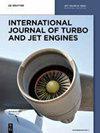Endwall heat transfer in wedge channel with teardrop pin fins, circular fins and oblong pin fins
IF 0.9
4区 工程技术
Q4 ENGINEERING, AEROSPACE
引用次数: 0
Abstract
Abstract The turbine inlet air temperatures exhibit a significant degree of elevation, hence leading to potential adverse consequences such as the degradation of blade material integrity. Consequently, the necessity to cool the turbine blades has arisen, leading to the implementation of various cooling systems. This study aims to conduct a comparative analysis of three different types of pin fins, namely oblong, circular, and teardrop, in a wedge duct. The range of Reynolds number considered for the analysis is between 10,000 and 70,000, whereas the pin fins and endwalls are subjected to a uniform heat flux of 3280 W/m 2 . The findings suggest that the friction factor associated with teardrop pin fins is 28.4 % lesser than circular pin fins and when compared to oblong pin fins; it is reduced by 34.5 %. The findings suggest that the friction factor associated with teardrop pin fins is 14 % lower compared to oblong and circular pin fins. The TPF improves with Re, and it is 24.5 % higher than oblong pin fin geometry and 39.2 % higher than circular shaped pin fins.带泪滴式、圆形和长方形三种翅片的楔形通道端壁换热
涡轮进口空气温度呈现出显著的升高程度,从而导致潜在的不利后果,如叶片材料完整性的退化。因此,冷却涡轮叶片的必要性已经出现,导致各种冷却系统的实施。本研究的目的是对楔形风管中三种不同类型的销翅进行对比分析,即长方形、圆形和泪滴形。分析考虑的雷诺数范围在10,000到70,000之间,而销钉鳍和端壁则承受3280 W/ m2的均匀热通量。结果表明:泪滴型销片的摩擦因数比圆形销片小28.4%,比长方形销片小28.4%;它减少了34.5%。研究结果表明,与椭圆形和圆形钉片相比,泪滴式钉片的摩擦系数降低了14%。随着Re的增加,TPF提高,比长方形销翅高24.5%,比圆形销翅高39.2%。
本文章由计算机程序翻译,如有差异,请以英文原文为准。
求助全文
约1分钟内获得全文
求助全文
来源期刊

International Journal of Turbo & Jet-Engines
工程技术-工程:宇航
CiteScore
1.90
自引率
11.10%
发文量
36
审稿时长
6 months
期刊介绍:
The Main aim and scope of this Journal is to help improve each separate components R&D and superimpose separated results to get integrated systems by striving to reach the overall advanced design and benefits by integrating: (a) Physics, Aero, and Stealth Thermodynamics in simulations by flying unmanned or manned prototypes supported by integrated Computer Simulations based on: (b) Component R&D of: (i) Turbo and Jet-Engines, (ii) Airframe, (iii) Helmet-Aiming-Systems and Ammunition based on: (c) Anticipated New Programs Missions based on (d) IMPROVED RELIABILITY, DURABILITY, ECONOMICS, TACTICS, STRATEGIES and EDUCATION in both the civil and military domains of Turbo and Jet Engines.
The International Journal of Turbo & Jet Engines is devoted to cutting edge research in theory and design of propagation of jet aircraft. It serves as an international publication organ for new ideas, insights and results from industry and academic research on thermodynamics, combustion, behavior of related materials at high temperatures, turbine and engine design, thrust vectoring and flight control as well as energy and environmental issues.
 求助内容:
求助内容: 应助结果提醒方式:
应助结果提醒方式:


